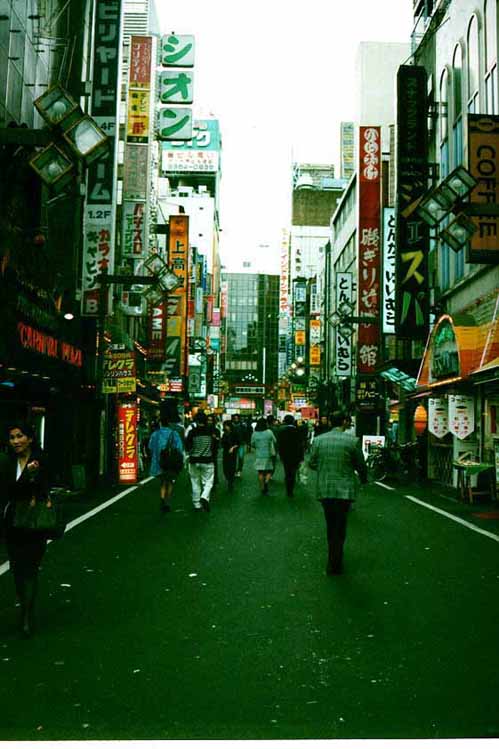 Giovanni`s
Giovanni`s
Adventure
Some time ago, Giovanni had the fortune to visit Tokyo as a guest chef at
one of the cities premier hotels. During the 3 week stay, Giovanni was taken
care of very royally and every effort was made to make him feel welcomed and
comfortable. Giovanni very quickly adjusted to the new culture and immensely
enjoyed the Japanese cuisine and hospitality. The host chef ensured that
Giovanni had a chance to eat in all of the many restaurants, in the hotel and
also gave him the opportunity to see some very neat downtown restaurants, not
frequently visited by westerner. Under the guidance of the host chef, Giovanni
experienced many different types of Japanese cuisines, from the sushi bar to the
shabu shabu sukiyaki, from teppan-yaki to the very formal traditional Japanese
restaurant. Giovanni was very impressed with the level of professionalism and
talent he experienced in the kitchen. Most of the Chefs and sous chefs where
European trained an were well versed with the classical cuisine.
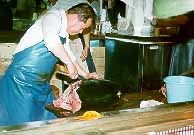 One of the highlight of the trip was a visit to
the Tokyo fish market. Tsukiji (pronounced skee-jee The World's Largest
Fish Market Giovanni had to get up early that day to ensure to make it there on
time, with his host chef as tour guide, Giovanni arrived around 5am, after a
short subway ride. They were greeted by the hotels fish supplier, which offered
to act as the tour guide. It was well worth the early morning get up and go,
Giovanni could not belief the hustle and bustle around the market. What an
incredible organized chaos!!
One of the highlight of the trip was a visit to
the Tokyo fish market. Tsukiji (pronounced skee-jee The World's Largest
Fish Market Giovanni had to get up early that day to ensure to make it there on
time, with his host chef as tour guide, Giovanni arrived around 5am, after a
short subway ride. They were greeted by the hotels fish supplier, which offered
to act as the tour guide. It was well worth the early morning get up and go,
Giovanni could not belief the hustle and bustle around the market. What an
incredible organized chaos!!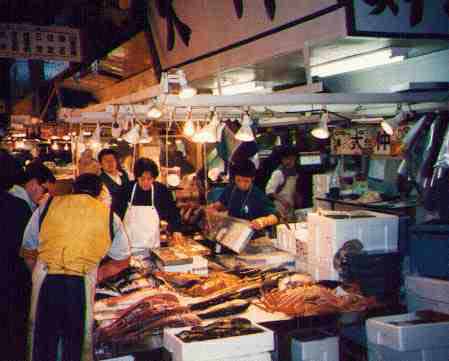 There was a
distinct smell of fresh seafood mixed with diesel fumes from all the trucks and
scooter that zoomed around. Once inside the smell of diesel gave Giovanni a
headache, but it had to be ignored as there was much to see. Giovanni was at awe
with the abundance of fish and seafood and his escort had to save him on a
couple of occasions from being run over by one of the scooters transporting fish
around the market!!
There was a
distinct smell of fresh seafood mixed with diesel fumes from all the trucks and
scooter that zoomed around. Once inside the smell of diesel gave Giovanni a
headache, but it had to be ignored as there was much to see. Giovanni was at awe
with the abundance of fish and seafood and his escort had to save him on a
couple of occasions from being run over by one of the scooters transporting fish
around the market!!
The market takes up 54 acres and supplies 90% of the fish eaten each day in
Tokyo. 15,000 workers are employed in the some 1200 wholesale fish shops in
Tsukiji. Styrofoam boxes of eels, squid, roe, crabs, lobsters, and endless
varieties of fish were lined up to be auctioned off. 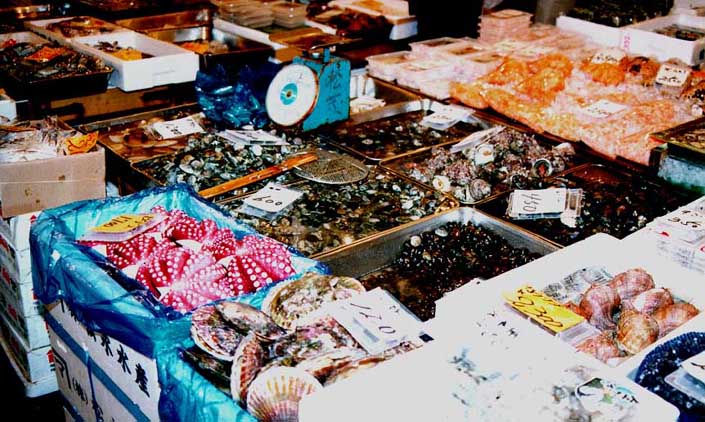 The most impressive size-wize are the tuna. Mist from the frozen fish rose in
the air as workers poured boiling water over an area near the tails, used huge
knives to slice them open, and inspectors came by to check and mark the fish
with red paint. The tuna auctions are especially exciting, with auctioneers
shouting out lots and bidders trying to keep pace. By 6:30 AM, the wholesalers
have carted their purchases back to their stalls, ready for restaurant owners to
arrive to pick out their fish for the day. A word of warning, if you intend to
visit the fish market, wear waterproof shoes or, even better, boots! The hoses
are running constantly with cold water to keep the place clean, and you'll have
wet feet unless you've come prepared.
The most impressive size-wize are the tuna. Mist from the frozen fish rose in
the air as workers poured boiling water over an area near the tails, used huge
knives to slice them open, and inspectors came by to check and mark the fish
with red paint. The tuna auctions are especially exciting, with auctioneers
shouting out lots and bidders trying to keep pace. By 6:30 AM, the wholesalers
have carted their purchases back to their stalls, ready for restaurant owners to
arrive to pick out their fish for the day. A word of warning, if you intend to
visit the fish market, wear waterproof shoes or, even better, boots! The hoses
are running constantly with cold water to keep the place clean, and you'll have
wet feet unless you've come prepared. 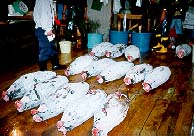
After watching these activitys and inspecting all the increible variety of
seafoods, Giovannis escord hinted, that it war time for breakfast . Breakfast
consisted of sushi made to order with the freshest of ingredients, some were
still alive!!. Freshly brewed green tea was served to flush the fishy breakfast
down.The whole meal was enjoyed in one of the many restaurant on the markets
permisses and in the company of friendly, polite market workers and Giovannis
two tour guides.
It was throughly a great experience and the only thing
Giovanni was longing for was a hot steaming cup of coffee.

The Markets
History
It is said that "Uogashi" or a riverside fish market dates back to the
16th century, the beginning of the Edo period. Tokugawa Ieyasu, the first
Tokugawa shogun and builder of Edo as is now Tokyo, invited fishermen from
Tsukudajima, Osaka and gave them a privilege for fishing in order to let them
supply seafood to Edo Castle. The fishermen purveyed fish to the Castle and sold
the remains near the Nihonbashi bridge. It was the origin of Uogashi. Then, to
meet the growing demand for fish with the increase in population, Nihonbashi
Uogashi was reformed and developed into a market. The market was lead by
wholesale merchants licensed by the Shogunate who bought fish from local ports,
sold them to jobbers in the market and thus built up a large fortune, forming
their own distributing network. Vegetables markets handling vegetables gathered
in the suburbs of Edo were established in Kanda, Senju and Komagome: the Edo's
three big vegetable markets. The markets attained prosperity led by wholesalers
and jobbers like fish markets. During the Edo period the market price was
determined chiefly by negotiated transactions between sellers and buyers. Public
auction was hardly taken place except in vegetable markets. In the Meiji and
Taisho eras, the privilege of wholesale merchants were abolished. In 1923 some
20 private markets in Tokyo were destroyed almost completely by the Great Kanto
Earthquake. After the earthquake, Tokyo City as it then was undertook to
construct a central wholesale market on the bases of the Central Wholesale
Market Law which had been promulgated in the same year. As a result, the three
markets of Tsukiji, Kanda and Koto were founded and the growing population then
led to a succession of new markets
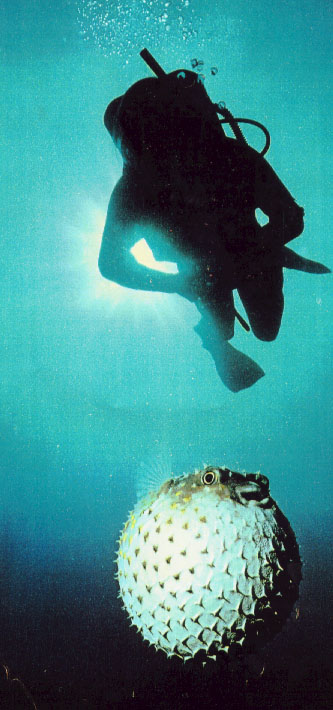
Fugu (Blowfish)
Deadly delicacy
From a recent article in Executive Lifestyle.
LOVERS eat it together so they won't be parted in death, poets have written
haikus about its deadly appeal, and it is one of few luxury foods never served
to the Japanese Imperial family. Indeed, few delicacies in the Japanese culinary
universe have as great a fascination as the puffer fish.
The small fish, which gets its name from its ability to blow itself up into a
fat little ball to protect itself from predators, is currently in season.
Abundant in the cool waters surrounding the Korean Peninsular, puffer fish or
fugu is popular in Japan as a winter-time treat. In pre-recession Japan,
companies commonly invited their top clients to lavish fugu feasts. There were
even lanterns made from fugu skin hanging outside the restaurant.
![Fugu on ice]()
Eaten in China for thousands of years and popular in Japan for the last few
centuries, the fish's deadly quality comes from the poison sacs in its ovaries
and liver. In medieval Japan, the elegant, death-defying ritual of eating fugu
in the winter was banned. Today, however, the handling of fugu is so heavily
legislated in Japan that fugu chefs need years of intensive study and a special
licence to handle the fish. And fugu that is destined for the export market is
doubly safe since it is handled by a licensed chef and certified safe by the
authorities before leaving the country.
"So eating fugu here in Singapore is very, very safe," says Yoshio Ishikawa,
manager of Inagiku Japanese restaurant at The Westin Plaza, as he hands us a
press pack complete with a copy of the restaurant chef's puffer fish licence.
Inagiku is featuring the fugu together with that traditional favourite, Kobe
beef, as part of its "Winter in Japan" promotion from Dec 1 to 26. Kobe beef,
silky smooth from all that marbled fat, is back by popular demand -- the
restaurant's previous Kobe beef promotion was six years ago.
But why the puffer fish? "It is very high-end food even in Japan and
everybody is very curious about fugu, so we wanted to see how Singaporeans would
take to it," says Mr Ishikawa.
There are many varieties of fugu but torafugu is the best, says Mr Ishikawa.
Inagiku serves fugu in several ways. As a sashimi, in a salad, as a soup served
steamboat style, and deep-fried.
We started with the sashimi (\\$130 a serving). Wafer-thin slices of fish were
laid out like some translucent work of art on a pretty blue dish. As always, a
little ritual accompanies the eating of this Japanese delicacy and pick a sliver
of fish up with your chopsticks, lay another equally thin piece of fish over it.
Delicately place some chopped radish and sliced spring onions on the fish, roll
the fish cum spring onions to form a "spring roll", dip in soy sauce (without
wasabe) and pop it into your mouth.
.jpg) Once you get over the shock of still being
alive, you realise that fuguis a very plain tasting fish,with none of the
richness of other cool water fishes like salmon or cod. What lifts the fugu from
being boring is an unusual bittersweet aftertaste which is subtle but lingering.
This barely discernible feature that rises from the fish's absence of flavour
must be part of the fugu's almost cult-like appeal. Mr Ishikawa assured us that
the fugu we were served was completely poison-free. In Japan,however, the best
fugu chefs are known to leave just enough poison in the fish to give diners a
tingling sensation on the lips and at the tip of the tongue, an exhilarating
near-death experience for fearless gourmets.
Once you get over the shock of still being
alive, you realise that fuguis a very plain tasting fish,with none of the
richness of other cool water fishes like salmon or cod. What lifts the fugu from
being boring is an unusual bittersweet aftertaste which is subtle but lingering.
This barely discernible feature that rises from the fish's absence of flavour
must be part of the fugu's almost cult-like appeal. Mr Ishikawa assured us that
the fugu we were served was completely poison-free. In Japan,however, the best
fugu chefs are known to leave just enough poison in the fish to give diners a
tingling sensation on the lips and at the tip of the tongue, an exhilarating
near-death experience for fearless gourmets.
The deep-fried fugu (\\$40) was nowhere as esoteric as the sashimi, but still
most enjoyable. The supreme freshness of the fugu lent itself very well to
deep-frying, head and all. Just as appealing, but in a totally different way,
was the fugu skin in a salad of piquant ponzu sauce (\\$10 for one portion). The
fugu skin (which, according to one Internet report, is also poisonous) has a
marvellous texture -- at once crunchy and chewy, it was reminiscent of jellyfish
but far better tasting.
In the steamboat, we almost forgot that the puffer fish was poisonous. It was
simply a good quality, fresh fish lightly cooked in a clear soup flavoured with
nothing more than wakame (seaweed) and accompanied by mushrooms, glass noodles
and veggies. Once again, the fish tasted unremarkable until you felt that sweet,
edgy aftertaste in yourmouth. Interestingly, in Japan, the highest incidence of
fugu poisoning comes from fish prepared by unlicensed home chefs in a
steamboat-style soup.
Talk to Giovanni
[ Sign my GuestBook
] - [ Read my
GuestBook ]
[ GuestBook by TheGuestBook.com ]
 >
>